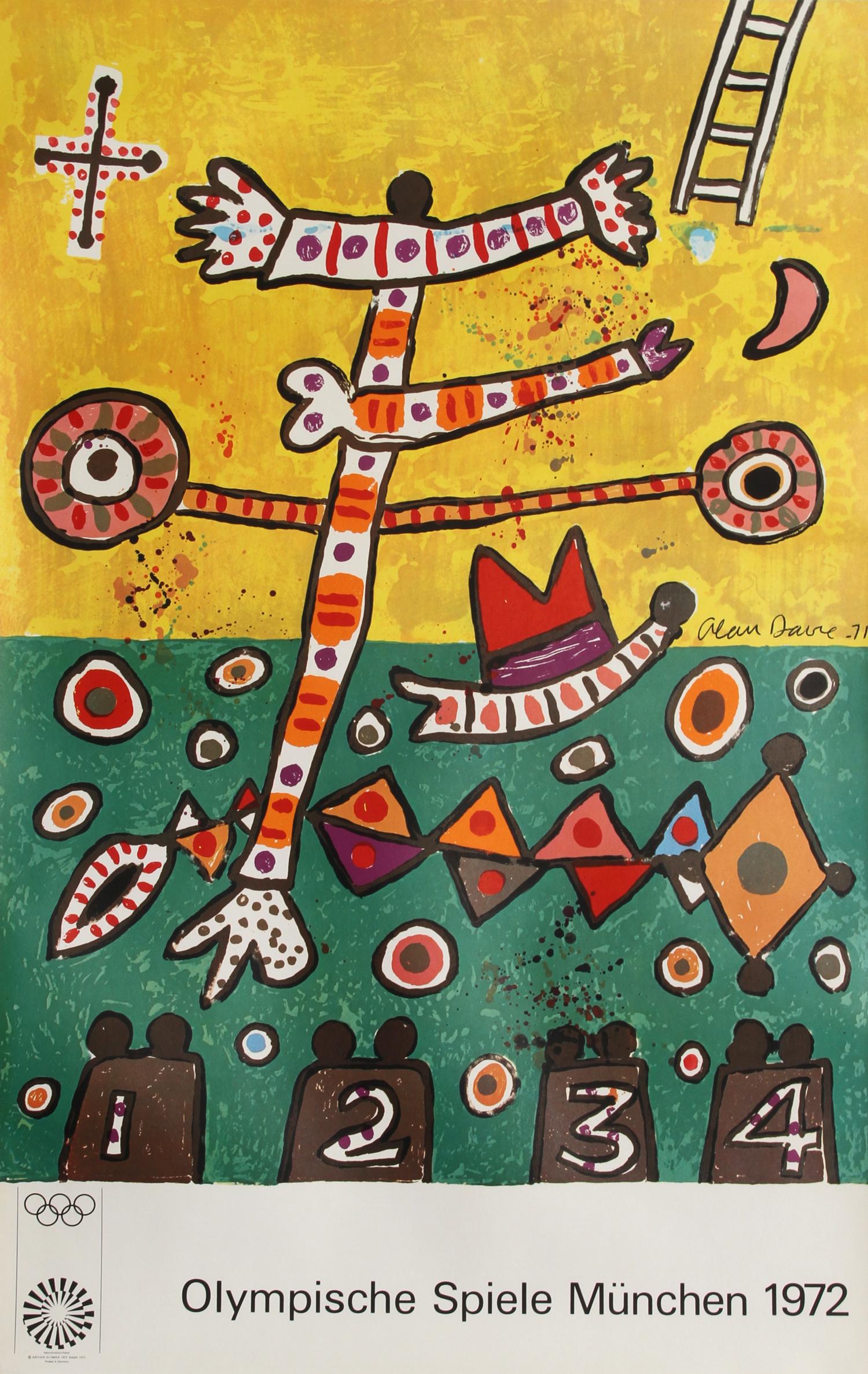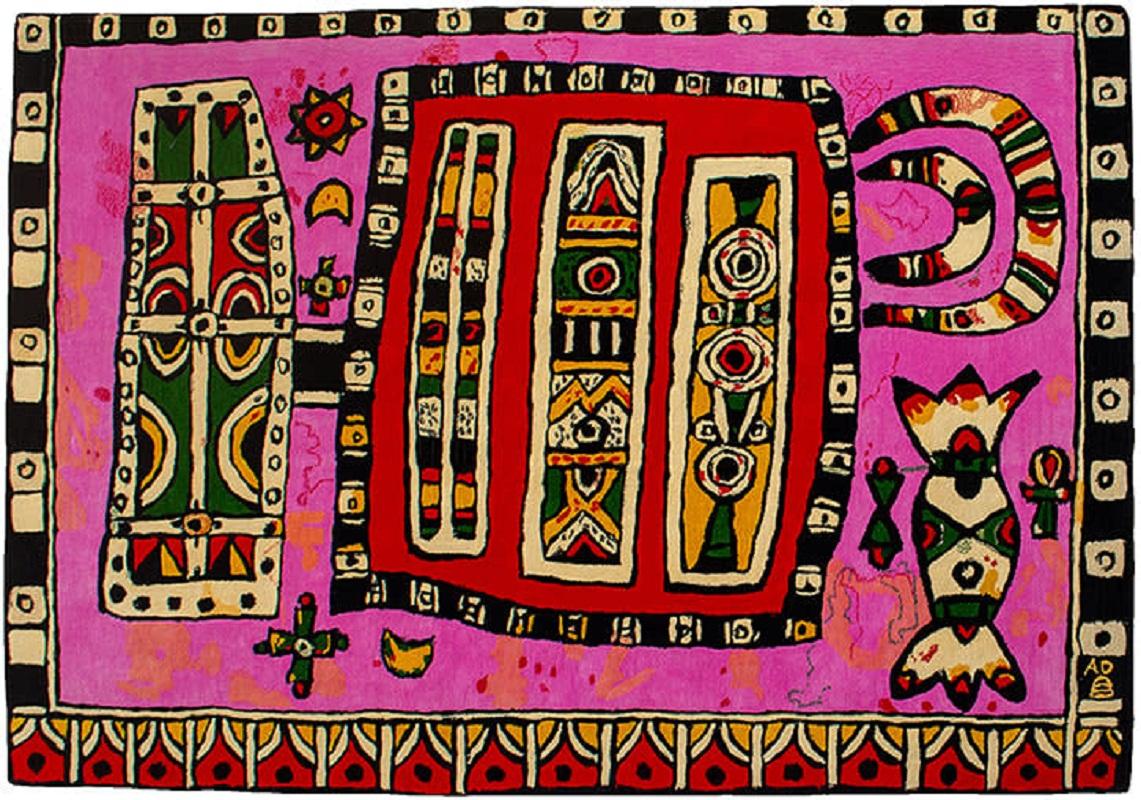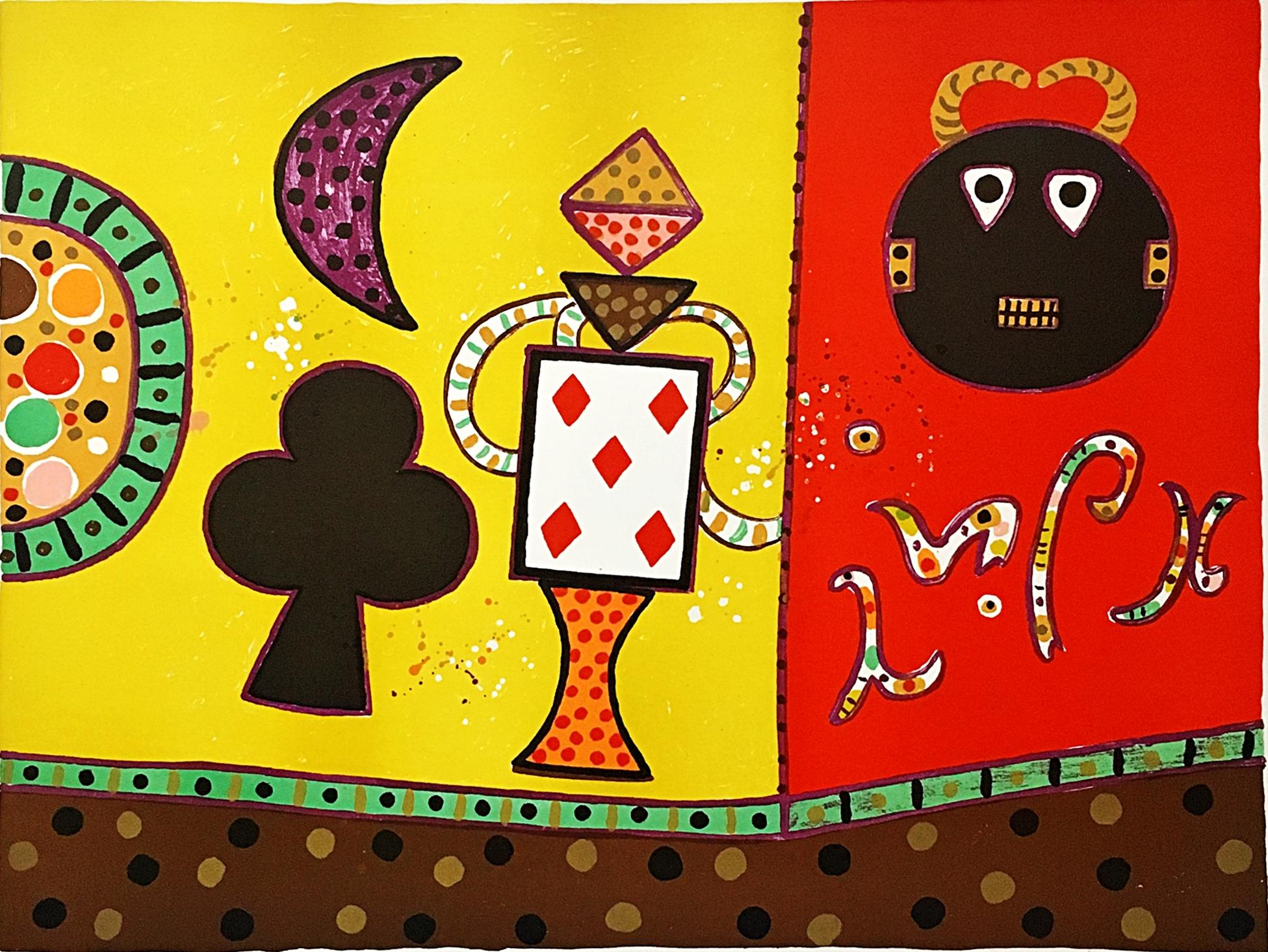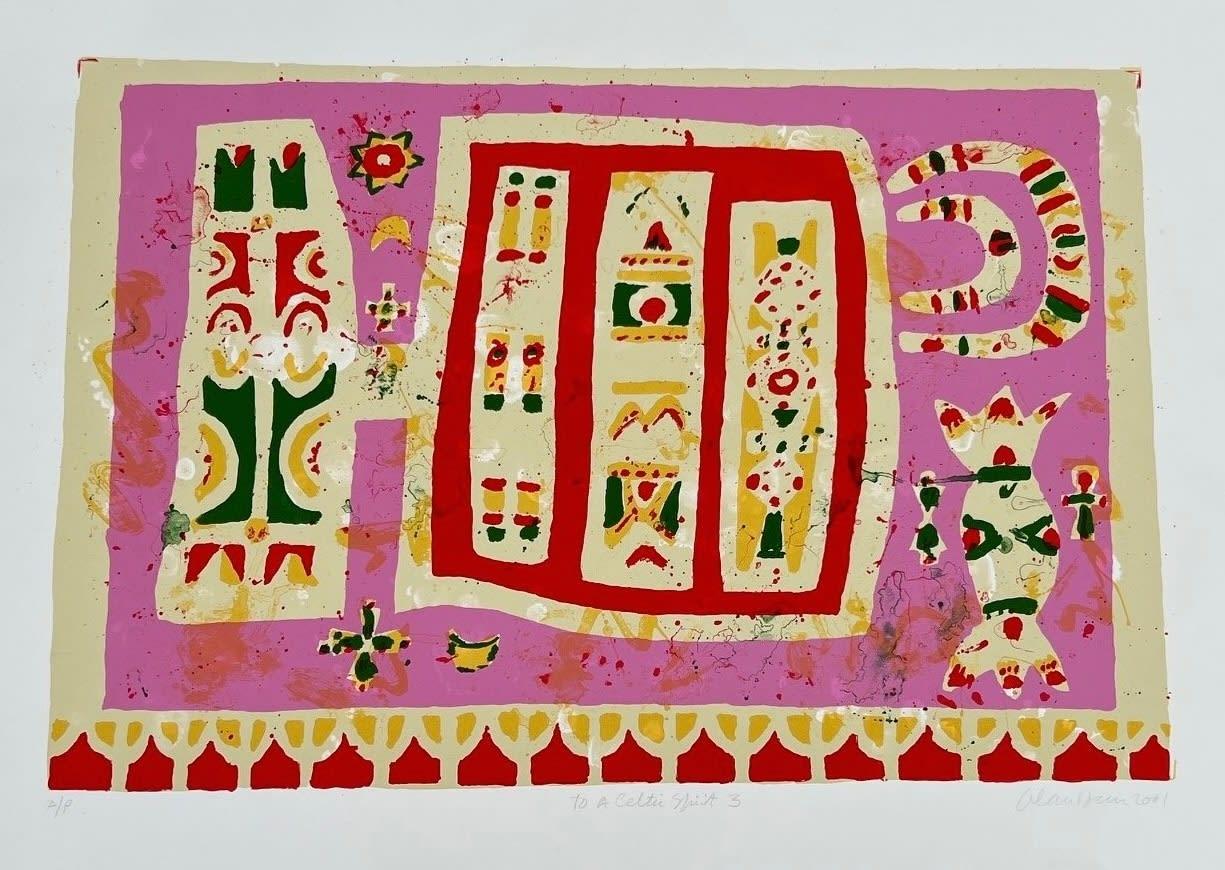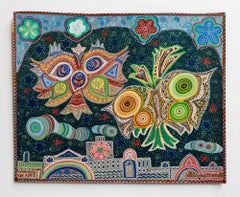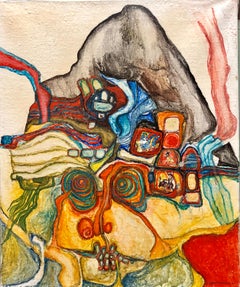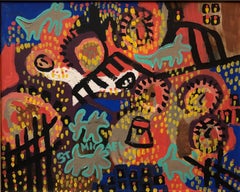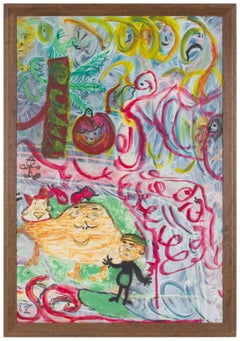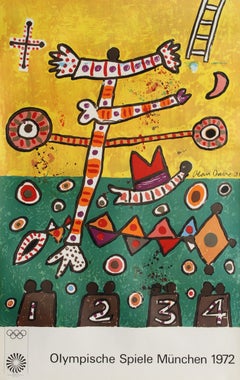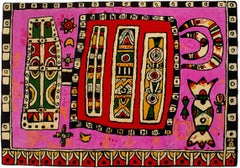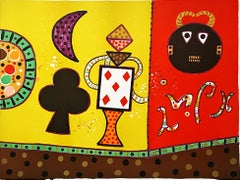Items Similar to Vibrant Alan Davie Scottish Colorful Surrealist British Pop Art Village Painting
Want more images or videos?
Request additional images or videos from the seller
1 of 18
Alan DavieVibrant Alan Davie Scottish Colorful Surrealist British Pop Art Village Painting1982
1982
$7,500
£5,613.35
€6,499.91
CA$10,423.78
A$11,740.69
CHF 6,080.08
MX$142,586.06
NOK 77,231.11
SEK 73,260.23
DKK 48,498.25
Shipping
Retrieving quote...The 1stDibs Promise:
Authenticity Guarantee,
Money-Back Guarantee,
24-Hour Cancellation
About the Item
Alan Davie, Scotland (1920-2014).
Gouache painting with watercolor
'Village Myth'
Hand signed ('with love') lower left,
1982
Dimensions: with frame 37.5"H x 30.25"W; image, 28"H x 22.5"W.
James Alan Davie (1920 – 2014) was a Scottish painter and musician.
Davie was born in Grangemouth, Scotland in 1920, the son of Elizabeth (née Turnbull) and James William Davie, an art teacher and painter who exhibited at the Salon des Artistes Français in 1925. During this formative period Davie discovered the poetry of Walt Whitman and T.S. Eliot, whose prose is echoed in letters home as well as his own verses.
Alan Davie studied at Edinburgh College of Art from 1937 to 1941. An early exhibition of his work came through the Society of Scottish Artists.
After the Second World War, Davie played tenor saxophone in the Tommy Sampson Orchestra, which was based in Edinburgh and broadcast and toured in Europe. He also earned a living making jewellery during the postwar period. Davie began teaching basic design in the jewellery department at London’s Central School of Arts and Crafts led by the Scottish artist William Johnstone, where colleagues included artists Nigel Henderson, Eduardo Paolozzi, Richard Hamilton and Patrick Heron. In 1961, Davie’s jewellery was featured in The International Exhibition of Modern Jewellery at London’s Goldsmith’s Hall, a milestone in the history of jewellery making in Britain where an impressive roster of international and British artists including Alexander Calder, Naum Gabo, Victor Pasmore and John McHale appeared in a section on ‘Modern Work by Sculptors and Painters’.
Davie travelled widely, unlike other British artists who made straight for Paris and stayed there, Davie ventured further afield. His experience of Switzerland, Italy and Spain was transformative, as revealed in the journals the artist compiled between April 1948 and March 1949 charting his encounters with art and nature and the development of his creative sensibility and in Venice became influenced by other painters of the period, such as Paul Klee, Jackson Pollock and Joan Miro, as well as by a wide range of cultural symbols. In particular, his painting style owes much to his affinity with Zen. Having read Eugen Herrigel book Zen in the Art of Archery (1953), he assimilated the spontaneity which Zen emphasises. Declaring that the spiritual path is incompatible with planning ahead, he attempted to paint as automatically as possible, which was intended to bring forth elements of his unconscious. In this, he shared a vision with surrealist painters such as Miró, and he was also fascinated by the work of psychoanalyst Carl Jung. nIn Paris he encountered modernist paintings by Pablo Picasso, Henri Matisse and Jean Arp. Like Pollock, many of Davie's works were executed by standing above the painting, which was laid on the ground. He added layers of paint until sometimes the original painting had been covered over many times. Despite the speed at which he worked (he usually had several paintings on the go at once), however, he was adamant that his images are not pure abstraction, but all have significance as symbols. Championing the primitive, he saw the role of the artist as akin to that of the shaman, and remarked upon how disparate cultures have adopted common symbols in their visual languages. In 1958 Alan Davie had his first solo exhibition at Wakefield Art Gallery, which went on to tour nationally and launched Davie’s career. A young attendee at the Wakefield exhibition was David Hockney, then a student at Bradford College of Art.
The exhibition was a pivotal influence on Hockney’s artistic development and shortly after this visit, Hockney moved to London to take up a place at the Royal College of Art. In addition to painting, whether on canvas or paper (he has stated that he prefers to work on paper), Davie produced several screenprints. He found a public for his work on the continent and in America some time before the British art public could reconcile itself to his mixture of ancient and newly invented symbols. In his lectures Davie stressed the importance of improvisation as his chosen method. His stance was that of an inspired soothsayer resisting the inroads of rational civilization. His unique surrealism style is marked by vibrant colours, semi-abstract shapes, and a captivating interplay of cross-cultural symbolism. Musically, Davie also played piano, cello and bass clarinet. In the early 1970s his interest in free improvisation led to a close association with the percussionist Tony Oxley. His paintings have also inspired music by others, notably the bassist and composer Barry Guy. Davie was invited to make a mural in 1987 for French artist Niki de Saint Phalle’s Tarot Garden in Garavicchio, Tuscany, brings together many aspects of his varied practice. Davie designed the jacket for R.W. Feachem's book Prehistoric Scotland, published by Batsford in 1963. The design was based upon motifs found on Pictish symbol stones. He died aged 93 in Hertfordshire, England on 5 April 2014. On 29 October 1947, in Edinburgh, Davie married Janet Gaul, a ceramic potter, artist, and designer. Together they had one child, a daughter, Jane, born in 1949
Art collections and museums owning work by Alan Davie include the Art Institute of Chicago, Dallas Museum of Art, Fine Arts Museums of San Francisco, Metropolitan Museum of Art, Museum of Modern Art, National Galleries of Scotland, Peggy Guggenheim Collection, Tate Gallery, Art Gallery of New South Wales, Brauer Museum of Art at Valparaiso University, Fred Jones Jr. Museum of Art at the University of Oklahoma, Harvard University Art Museums, Hirshhorn Museum and Sculpture Garden, Mildred Lane Kemper Art Museum, Oklahoma City Museum of Art, The Priseman Seabrook Collection, San Diego Museum of Art, Southampton City Art Gallery, The Hepworth Wakefield and Worcester City Art Gallery & Museum.
Discography
The Alan Davie Music Workshop (ADMW, 1970)
Suite for Prepared Piano and Mini Drums (ADMW, 1971)
Bird Through the Wall (ADMW, 1971)
Phantom in the Room (ADMW, 1971)
The Tony Oxley/Alan Davie Duo (ADMW, 1975)
Elaboration of Particulars (Confront, 2021
His work is amongst the finest of modern British printmaking alongside Richard Smith, Joe Tilson, Malcolm Morley, Terry Frost, and Howard Hodgkin.
- Creator:Alan Davie (1920, British)
- Creation Year:1982
- Dimensions:Height: 37 in (93.98 cm)Width: 30 in (76.2 cm)
- Medium:
- Movement & Style:
- Period:
- Condition:
- Gallery Location:Surfside, FL
- Reference Number:1stDibs: LU38214495702
Alan Davie
Painter, born in Grangemouth, Stirlingshire. His father was also an artist and Davie junior was encouraged to enrol at Edinburgh College of Art, 1937-40, where he was taught by John Maxwell. Following army service with the Royal Artillery in World War II, Davie worked variously as a jazz musician, textile designer, potter and as a jewellery designer. In 1946, he held his first solo exhibition at Grant's Bookshop, Edinburgh and soon after travelled around Europe meeting Peggy Guggenheim which was to broaden his artistic outlook. His work over the years was much influenced by Abstract Expressionism, Oriental mysticism and Indian mythology. His first London show took place at Gimpel Fils, London in 1950 and his first New York exhibition at the Catherine Viviano Gallery, New York in 1956. During the 1960's and later many of Davie's drawings appeared in print form executed by the Curwen Press and also were seen in the eclectic magazine Motif. Davie was awarded the Gregory Fellowship at Leeds University 1957-59 and in 1962 he held a retrospective exhibition in Amsterdam at the Stedelijk Museum. Other retrospective exhibition venues include the McLellan Galleries, Glasgow, 1992, RWA Bristol, 1992, Barbican Art Gallery, London, 1993 and 'Jingling Space' held at Tate St. Ives. This highlighted Davie’s works from the 1930’s to the millennium. Examples of his work are in the collections of the City Arts Centre, Fleming Collection, Harrogate Art Gallery, Jerwood Foundation, Lillie Art Gallery, MoMa, New York, Museums Sheffield, NCAS, Peterborough Museum & Art Gallery, Tate Gallery, Towner Art Gallery, Ulster Museum, University of Warwick Art Collection, V&A, Worcester Art Gallery and major museums around the world including MoMA, New York. Alan Davies was appointed CBE in 1972, a senior member of the RA in 2012 and a major exhibition of his work opened at the Tate Britain a few days after his death.
About the Seller
4.9
Platinum Seller
Premium sellers with a 4.7+ rating and 24-hour response times
Established in 1995
1stDibs seller since 2014
1,777 sales on 1stDibs
Typical response time: <1 hour
- ShippingRetrieving quote...Shipping from: Surfside, FL
- Return Policy
Authenticity Guarantee
In the unlikely event there’s an issue with an item’s authenticity, contact us within 1 year for a full refund. DetailsMoney-Back Guarantee
If your item is not as described, is damaged in transit, or does not arrive, contact us within 7 days for a full refund. Details24-Hour Cancellation
You have a 24-hour grace period in which to reconsider your purchase, with no questions asked.Vetted Professional Sellers
Our world-class sellers must adhere to strict standards for service and quality, maintaining the integrity of our listings.Price-Match Guarantee
If you find that a seller listed the same item for a lower price elsewhere, we’ll match it.Trusted Global Delivery
Our best-in-class carrier network provides specialized shipping options worldwide, including custom delivery.More From This Seller
View AllIsraeli Folk Art Bright Colorful Naive Jerusalem Vibrant Landscape Painting
By Menia Litvak
Located in Surfside, FL
My life as an artist started in 1976 when I left Kishinev (Bessarabia) for Israel. In my youth I did not have the opportunity to study an regularly, although I learned painting during some two years at the Belle-Arts Academy in Kishinev and one year in Bucarest. My youth was spent during world war 2 when Bessarabia was annexed by the Soviet Union, years of hunger and the need to work very hard to be able to survive. I worked as a retoucher of photographs in a studio. When I arrived in Israeli went to live in Jerusalem and took up painting as my only ocupation, not as in Russia where it was one of my occupations which I had to do sometimes in hiding, stealong time from my everyday jobs. Israel, its colourings, impressed me much: the blue of the sky, the turquoise of the sea, the palette of desert colours. The stones of Israel looked alive and I wished I could paint them all. In 19761 started to expose my work. Since then I participated in a number of exhibitions in groups and alone. Since 1984 I am a member of the Israeli Union of Painters and Sculptors. The last exhibition where I took part was at the Salon des Beaux-Arts in Paris together in a group of Jerusalem artists. Israel has had a Vibrant Folk Art, Naive art scene for a long time now artists like Yisrael Paldi, Nahum Guttman...
Category
20th Century Folk Art Figurative Paintings
Materials
Gouache
French Jewish Post Holocaust Abstract Painting Manner of Hundertwasser Art Brut
By Jichak Pressburger
Located in Surfside, FL
Jichak Pressburger, Painter. b. 1933, Bratislava, Czechoslovakia. A concentration camp survivior. Came to Israel aboard the ship, "The Exodus". 1964 Went to Paris. In 1979 Returned as new immigrant.
Education Tel Aviv University, B.A. in art, with Marcel Janco and Isidor Ascheim at Avni art school.
Beaux Arts, Paris with Professor Coutaud.
Itzchak Pressburger
Stays in Paris from 1963 – 1979, Resident of the “Cité des Arts” 1969-1972. Lives and works in Jerusalem since 1979.
One-Man Exhibitions
1963 Gallery Dugit, Tel-Aviv
1968 Cultural Center Enkhuizen, Netherlands
1968 Gallery Zunini, Paris (chosen by the art critic of « Opus : Jean-Jacques Lévèque)
1970 Gallery Zunini, Paris
1973 Gallery Maitre Albert, Paris. Cultural Center Verfeil sur Seye, France
1974 Gallery Maitre Albert, Paris
1976 Gallery Mundo, Barcelone
1980 Artists’ House, Jerusalem
1981 Gallery Alain Gerard, Paris
Group Exhibitions
1966 Rathaus Charlottenburg, Berlin. (The first show of Israeli painters in Germany
Artists Center of Silvarouvres, Nantes, Ffance
XXXth Salon of Finances at “l’Hotel des Monnaies”, Paris
1969 Maison de Culture, Le Havre, France
1968 Gallery Zunini, Paris (chosen by the art critic of « Opus : Jean-Jacques Lévèque)
Salon « Grands et Jeunes d’Aujourd’hui », Paris
Museum of Fine Arts, Nantes, France
Cultural Center Vitry, France
Gallery Il Giorno, Milan
Cité des Arts, Paris
1972 Salon “Grands et Jeunes d’Aujourd’hui”, Paris
Salon de Mai, Paris
1973 Städtische Galerie, Siegen, Germany
1974 Jewish Cultural Center, Paris
Publicis, Paris
1975 Réalitiés Nouvelles, Paris
1976 Salon de Mai, Paris
1977 “Perspectives Israeliennes”, Grand Palais, Paris
1981 Salon Alain Gerard, Paris
1984 Artists’ House, Jerusalem
Publication
1990 Haggadah Yom Kippour (Hebrew/French) Abraham Bliah (private edition), Paris
Acquisitions
1968 The City of Paris
1972 The State of France
The Yitzchak Pressburger artist was born in Bratislava – known for centuries by its German name of Pressburg – but the outbreak of World War II found him and his family in Prague. His father realized they had to escape from the Nazi occupiers and tried to get the family across the border into Hungary. However, they were caught near the crossing point, arrested and incarcerated overnight at the nearby railway station. The Czechs put them on a train to Hungary early the next morning. That was their first miracle in their quest for survival.
They survived with relative ease until late 1943, when the father was taken away to a forced labor camp. He subsequently died in a death march. Things became even more precarious in early 1944, when the Holocaust made its full-blown presence felt in Hungary.
“It wasn’t the Germans, it was the Hungarian Nazis who did the dirty work,” Pressburger points out. The family lived in so-called “safe houses” that were protected by Switzerland, Finland and Sweden. The havens were dismantled in late 1944, and the Pressburgers moved into one of the two Jewish ghettos in Budapest. The Nazis had found two houses with Jews, including the one where we had been, and took them all out and shot them next to the Danube. Today there is a monument by the river [called Shoes on the Danube Bank]. We should have been with the Jews who were killed by the river,” he says.
After the war, Pressburger and his siblings were farmed out to various orphanages run by the Jewish Agency, and things took a decidedly better turn.
“We finally had food to eat,” he recalls. “After a while we were put on trains that were protected by the Jewish Brigade [of the British Army], and we were sent to Austria, and then to Germany.”
“My uncle was a famous artist, and I learned a lot from him,” he says. While in Germany, Pressburger also took some lessons with a local artist.
His mother managed to get him and two of his siblings berths on the Exodus, which set sail from Marseilles for Palestine in July 1947. Pressburger was 13 at the time and clearly recalls the aborted attempt to get to the Promised Land.
“It was so crowded on the boat. This was a ship that was made to ply rivers in the United States, with a few hundred people on board, and we had over 4,500 passengers crammed in.”
As we know, the British prevented the Exodus from docking in Palestine, and the passengers were shipped – in three far more seaworthy vessels – back to France. After the French government refused to cooperate with the British, Pressburger and the others found themselves back in Germany. The teenager eventually made it here in 1948, just one month before the Declaration of Independence.
After a short furlough in Tel Aviv, during the first lull in the fighting in the War of Independence, he moved to Kibbutz Kfar Ruppin, where he worked in the cowshed. All the while he continued feverishly drawing and honing his artistic skills, which he says came in handy when he joined the IDF.
After completing his military service, which included a spell as one of the founding members of the Flotilla 13 naval commando unit, he worked in Sdom for a while at the Dead Sea Works before starting his formal arts training in earnest.
I was in the first group of students at the Avni Institute [in Tel Aviv],” he says. “There was quite a famous bunch of students and teachers like Moshe Mokadi and Isidore Ascheim and Aaron Giladi.”
In such illustrious company, one might have thought Pressburger was set to unleash his burgeoning talents on art connoisseurs across the globe, but it was a while before that happened.
Pressburger arrived in the French capital in 1964 and spent close to 15 years there, with a short interlude in Germany, before returning to Israel. His time in Paris was a professionally rewarding period of his life, and he also found love.
“[Avni Institute teacher] Yochanan Simon gave me the name and address of a French-Israeli family in Paris, but when I got to the house, a young woman opened the door and told me the family was on vacation in Israel,” he explains. Despite missing his expected hosts’ welcome, he and the German-born young lady who greeted him soon fell for each other, and romance quickly led to wedding bells. By all accounts, Pressburger did well in Europe. He secured a rare three-year berth at Cité Internationale des Arts, where artists are normally provided with accommodation and studio space for between two months and a year. He was also accepted to the prestigious Beaux Arts academy of fine arts, mounted solo exhibitions, and took part in group shows all over Europe.
One of these last was a group exhibition at Rathaus Charlottenburg in Berlin in 1966 – the first exhibition of Israeli artists in Germany after the Holocaust. When he arrived in Berlin, the lineup for the Israeli show was already signed and sealed, but somehow his work came to the attention of the German culture minister, who arranged for him to join. The Pressburgers’ year-long sojourn came to an abrupt end following an encounter he had one day while walking through the crowded Berlin streets...
Category
1960s Expressionist Abstract Paintings
Materials
Canvas, Oil
Street Art Outsider Art Painting Abstract Cityscape with Dogs
Located in Surfside, FL
Done in a manner reminiscent of Keith Haring and LA Ortiz.
Category
Late 20th Century Street Art Abstract Paintings
Materials
Acrylic
Untitled Acrylic and Marker Outsider Art Surrealist Dreamscape
By Hilda Arvey
Located in Surfside, FL
Hilda Arvey started painting at the age of 70. Self Taught, Art Brut, Outsider artist. Mother of celebrated Chicago artist Phyllis Kresnoff.
Category
Mid-20th Century Outsider Art Abstract Paintings
Materials
Acrylic, Permanent Marker
Polish French Figurative Abstract Art Brut Expressionist Lithograph Maryan
By Pinchas Maryan
Located in Surfside, FL
Pinchas Burstein, known as Maryan
Lithograph (after the drawing).
1960
Dimensions: 12 3/8 x 9 3/8 inches (315 x 240mm).
There is printed text on the back, as issued.
Signed in the...
Category
1960s Expressionist Figurative Prints
Materials
Paper, Lithograph
Pop Art Brut Collage Mixed Media Print, Painting, Burning, Tape, Marty Greenbaum
Located in Surfside, FL
Marty Greenbaum (1934-2020)
''Brooklyn Local in Wisconsin''
Lithograph, with hand-coloring, blind stitching, stitching, burning, tape collage and paint
with Jewish, Hasidic, Sleepy Moishy character.
Marty Greenbaum (1934-2020) was an American painter, mixed media assemblage and book artist.
Greenbaum is best known for his mixed media assemblage, painting and artist books. Greenbaum appeared in three films: Hallelujah the Hills in 1963 by Adolfas Mekas, Life Dances On, in 1980 by Robert Frank, and The Present in 1996 by Robert Frank. Between 1962 and 1965 he took part in happenings by Allan Kaprow and experimental dance by Yvonne Rainer. Greenbaum authored his own happenings, i.e. Coney Island Carny, including artists such as Eddie Barton, Remy Charlip, Paul Kaplow, Paul Krasner, Al Hanson, Ed Blair, Allen Ginsberg, John Hammond, Eddie Rabkin, Lou Gossett, Renee Renee, Allan Kaprow, Phyllis Yampolsky, Thomas Hoving, Jackie Ferrara, Peter Schumann, Jim Bell, Bill Marshall, Corla Lopez, Bruce Waite, and Mark di Suvero, as well as organizing the Hall of Issues with Phyllis Yampolsky at The Judson Memorial Church.
Greenbaum had several teaching positions in the New York City public school system and was a member of the Creative Artists Public Service program twice, he also participated in various exhibitions with book objects. His work is in several public collections including The Art Institute of Chicago, Artists' Books, The Brooklyn Museum Collection, The Chrysler Museum, Norfolk, VA, Citibank, NYC, Colgate University, Hamilton, NY, Jacksonville Art Museum, Jacksonville, FL, Madison Art Center, Madison, WI, SUNY at New Paltz, NY and more.
Books as Objects
"Greenbaum, an early conceptualist, burned books in the 1960s, exhibiting the remains as 'corpses.' Today, he makes fetishistic notebooks filled with colored paper and scribbled equations, accretions of feathers and Rhoplex."
"Marty Greenbaum and Barton Lidice Benes destroy texts to create sculpture: Benes 'Bound Book,' a literal rope and wax imprisonment, and Greenbaum's 'Cutting Up,' a mixed media paste over of muted colors." Some of his most notable artist books include: "Batman" 1963-67, "In '84 Returned in 2004". Two stories about Marty from James Pernotto: we met at William Weege print shop in 1974 when he drove out from NYC with Alan Shields and Paco Grande and I was a lithography printer hired to work with them. Alan recalled on the trip out that Marty was working on his altered books and putting airplane glue on the pages and lighting it with a match. Enough said. I printed for Marty.
Solo exhibitions
2007 Two Artists, Windsor Whip Works, Windsor NY
2001 Pacifico Fine Art, NYC
1972, 1979, 1985 Allan Stone Gallery, NYC
1977 Picker Art Gallery, Colgate University, Hamilton NY
1963, 1964, 1965 Stryke Gallery, NYC
Group and Traveling exhibitions
2019 One Plus One Equals Three, curated by Roger Winter, Kirk Hopper Fine Art, Dallas, TX
Collage and assemblage by Romare Bearden, Roy Fridge, Marty Greenbaum, David McManaway, Robin Ragin, Nancy Willis Smith, and Roger Winter.
2017 Sorcery & Craft, Allan Stone Projects, New York, NY
2008 8 Artists 8 Books, 5 + 5 Gallery, Brooklyn, NY
1999 Talent, Allan Stone Gallery, New York, NY
1998 Artist Books, Bound & Unbound Gallery, New York, NY
1992 Fetishism, Allan Stone Gallery, New York, NY
Salon of the Book, Caroline Corre, Paris, France; Artists; Books, Centre Georges Pompidou, Paris, France
1979 "Book Makers: Center for Book Arts First Five Years", Arthur A. Houghton, Jr. Gallery, The Cooper Union, NYC
1978 The Detective Show MoMA, PS1, Queens, NY (with Richard Artschwager and Gordon Matta Clark...
Category
1970s Arte Povera Mixed Media
Materials
Paint, Tape, Mixed Media, Lithograph
You May Also Like
Olympische Spiele Muenchen, Folk Art Lithograph by Alan Davie
By Alan Davie
Located in Long Island City, NY
Artist: Alan Davie, Scottish (1920 - 2014)
Title: Olympische Spiele Muenchen
Year: 1972
Medium: Lithograph Poster mounted on linen
Edition: ...
Category
1970s Folk Art Abstract Prints
Materials
Lithograph
Celtic Spirit II by Alan Davie, 2000
By Alan Davie
Located in Kingsclere, GB
Celtic Spirit II by Alan Davie, 2000
Additional information:
Medium: screenprint
74.5 x 97.5 cm (unframed)
29 3/8 x 38 3/8 in
signed, dated and numbered in pencil
Alan Davie is one...
Category
20th Century Abstract Prints
Materials
Screen
Olympische Spiele Muenchen, Signed Folk Art Lithograph by Alan Davie
By Alan Davie
Located in Long Island City, NY
Artist: Alan Davie, Scottish (1920 - 2014)
Title: Olympische Spiele Muenchen
Year: 1972
Medium: Lithograph, signed and numbered in pencil
Ed...
Category
1970s Abstract Expressionist Abstract Prints
Materials
Lithograph
Guli Wall rare 1970s lithograph by famed Scottish Pop artist Alan Davie Signed/N
By Alan Davie
Located in New York, NY
Alan Davie
Guli Wall, 1971
Lithograph on Rives BFK Paper with Deckled Edges
Hand signed, numbered 26/200 and dated on the lower front
20 × 25 1/2 inches
Unframed
This whimsical mid-century modern hand signed, dated and numbered print by renowned Scottish-born British Pop artist Alan Davie published in 1971 was chosen to be included in the 1975 portfolio for the Swiss Society for Fine Arts (Grafikmappe des Schweizerischen Kunstvereins) as part of an international portfolio of 27 prints by world renowned artists including Jasper Johns, Christo, Valerio Adami, Shusaku Arakawa, Robert Cottingham, Richard Paul Lohse, Gerhard Richter, Dieter Roth, Pierre Tal Coat and many others.. Hand signed and numbered from the edition of 200. Unframed and in fine condition. This vintage European print...
Category
1970s Abstract Abstract Prints
Materials
Lithograph
Celtic Spirit III by Alan Davie, 2001
By Alan Davie
Located in Kingsclere, GB
Celtic Spirit III by Alan Davie, 2001
Additional information:
Medium: screenprint
74.5 x 97.5 cm (unframed)
29 3/8 x 38 3/8 in
signed, dated and numbered in pencil
Alan Davie is on...
Category
21st Century and Contemporary Abstract Prints
Materials
Screen
Sport Party - Lithograph (Olympic Games Munich 1972)
By Alan Davie
Located in Paris, IDF
Alan DAVIE
Sport Party
Lithograph
Printed signature in the plate
On edition paper 101 x 64 cm (c. 40 x 26 inch)
Made for the Olympic Games in Munich, 1972
Excellent condition
Category
1970s Abstract Figurative Prints
Materials
Lithograph
More Ways To Browse
Village Painting
Colorful Spanish Art
Original Scottish Art
Chicago Pop Art
Spanish Pop Art
Scottish Modern Art
Matisse Watercolour
Edinburgh Scotland Art
1958 Abstract Drawings
Scottish Watercolor
Scottish Watercolour
Pop Surrealism Art
Pop Art Jewelry
Spanish Village Painting
Spanish Village
Pop Art Ceramic
Kemper Paintings
Tarot Art
